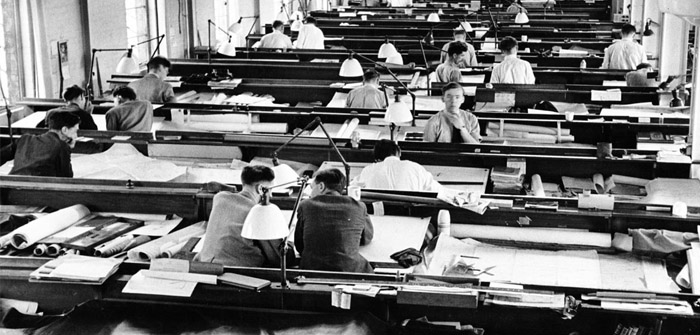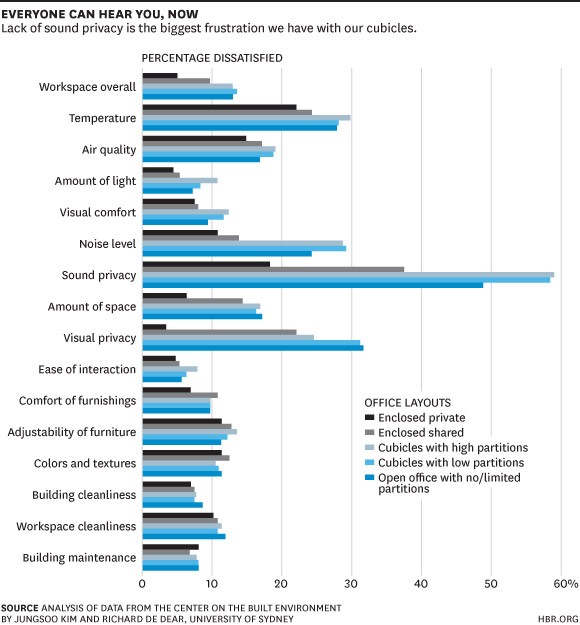(Photos | Courtesy of Audio Visual Bend)
Ah, the open-plan office, that shining example of egalitarian design, the great leveler of the corporate caste system. Just one problem: there’s no privacy. Open-plan offices are distractingly noisy. Their intended purpose is to boost collaboration and productivity, but these designs have actually done quite the opposite. Research shows that open-plan workspaces damage employees’ attention spans, stress levels, short-term memory, productivity, creative thinking and satisfaction. A 2003 Herman Miller study on privacy issues cited “overheard conversation” as workers’ biggest complaint. In fact, office chatter is such a common performance-killer that the outcome even has a name: “the irrelevant speech effect.” And yet 70 percent of U.S. workplaces still embrace an open-plan environment.
Short of reverting to private offices — which many organizations simply can’t afford — what’s the solution? Simple. Focus on an overlooked element of office design: sound.
Close your eyes right now and just listen for 30 seconds. What do you hear? The click of a neighbor’s keyboard? The hum of the AC? Your stomach telling you that you shouldn’t have had that second doughnut? Sound is there — everywhere, all the time — and it’s affecting what you think, feel and do. Over the course of a career scoring TV, sports, drama and news, I’ve learned to put the power of sound to work, and I believe we can use it to regain some of the privacy, performance and well-being that open-plan offices have sapped from us. Indeed, that Herman Miller study showed that sound masking can increase productivity by up to 38 percent, reduce stress by up to 27 percent, and increase job satisfaction by up to 174 percent.
At the new Man Made Music offices in New York City, we’ve taken a holistic approach, creating an immersive soundscape complete with sonic art installations, featured playlists and coordinating lighting cues. It was a lot of work, but it works, and it helps us work effectively and happily. Organizational solutions don’t have to be that intense, though. At the Chicago headquarters of financial research company Morningstar, simple ceiling speakers direct white noise down into cubicle spaces, creating noise-canceling cones of silence that allow colleagues working within feet of each other to carry on simultaneous phone or in-person conversations. Companies might also try “pink noise” — white noise’s speech-masking cousin — to enable deeper focus, concentration and productivity. Organizations that address issues of sound privacy will be tackling employees’ number-one complaint about their open workspaces, according to a University of Sydney analysis:
If you’re among the sufferers and your company isn’t doing much to help, grab your headphones and try some DIY soundscaping. Start the morning right with sounds that elevate your energy and mood. This could be music, news radio, or a meditation CD — whatever makes you happy and calm. When you need to focus, tune in to playlists. White Noise and Be Productive are two I’ve created to help drown out the chatter and help you get more done. You can also explore sound apps like Thunderspace, which creates a bed of white noise; Coffitivity, which mimics the sounds of a coffee shop at various times of day; and Ambiance, which offers a wide array of productivity noises. During breaks, cleanse your sonic palate. Step outside and take in the sounds of life — cars, birds, your fellow human beings. Widen your focus and reorient yourself to your purpose before you return to the office.
Sound has the ability to grab your attention, spark your imagination and play on your emotions. Organizations, and workers themselves, should start putting it to better use.
Source: Joel Beckerman is the founder and lead composer of Man Made Music, a company specializing in sonic branding.
Local Acoustical Projects Audio Visual Bend Addressed:
- AP Finance
- RIFF
- ODOT
- Smart Solution
- Bend International School
- Summit High School
TonytheAVGuy.com • AVDesignsNow.com






